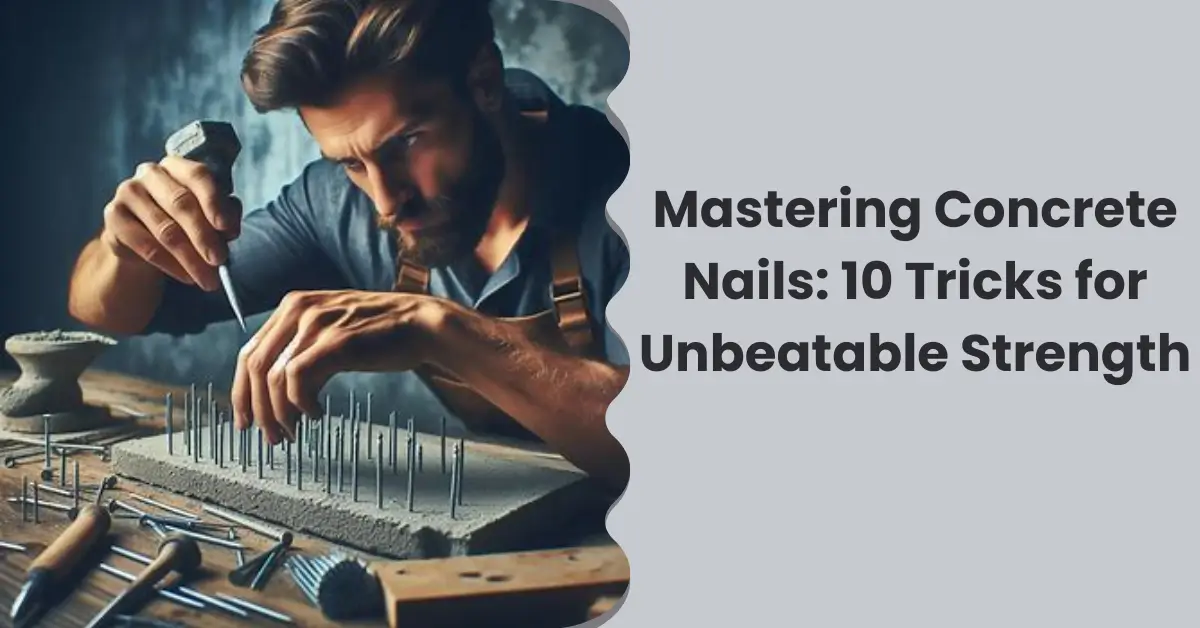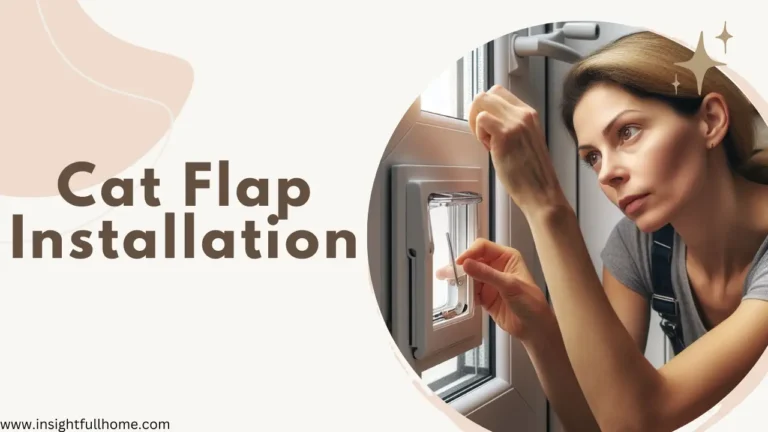Introduction: Dispelling the Myth about Concrete Nails
When it comes to construction, the unsung hero often overlooked is the humble concrete nail. Contrary to common belief that these nails are just for basic use, there’s a world of untapped potential waiting to be discovered. In this guide, we’ll delve into the intricacies of concrete nails, unveiling their versatility and the transformative impact they can have on your projects.
So, buckle up as we debunk the notion that concrete nails are only for the basics. Get ready to explore a universe of possibilities that will redefine your construction experience!
Table of Contents
Understanding the Basics of Concrete Nails
Concrete nails, often underestimated, play a pivotal role in ensuring the stability and durability of structures. These nails are specifically designed for use in hard materials like concrete and masonry. It’s not just about fastening; it’s about achieving a level of strength that withstands the test of time.
When we talk about “concrete nails,” we encompass a variety of specialized fasteners, each tailored for specific applications.
To truly harness the power of concrete nails, it’s essential to understand their purpose. Unlike traditional nails, these are not one-size-fits-all. Their unique design and composition make them ideal for penetrating rough surfaces, providing a secure anchor for various construction elements.
From framing to finishing touches, the right type of concrete nail can make all the difference.
Selecting the Best Concrete Nails for Your Project
Now that we’ve shattered the myth surrounding concrete nails, let’s explore the world of options available. Choosing the right type of nail for your project is a crucial step in ensuring its success.
Whether you’re working on an outdoor deck or an indoor renovation, understanding the specific demands of your project is key.
Different types of concrete nails cater to distinct needs. Common variations include round-headed, fluted, and hardened nails. Each excels in specific applications, providing varying levels of holding power and resistance to corrosion.
Consider the nature of your project, the load it will bear, and the environmental conditions it will face. Armed with this knowledge, you can confidently select the best concrete nails for optimal performance.
Mastering the Art of Secure Fastening Techniques
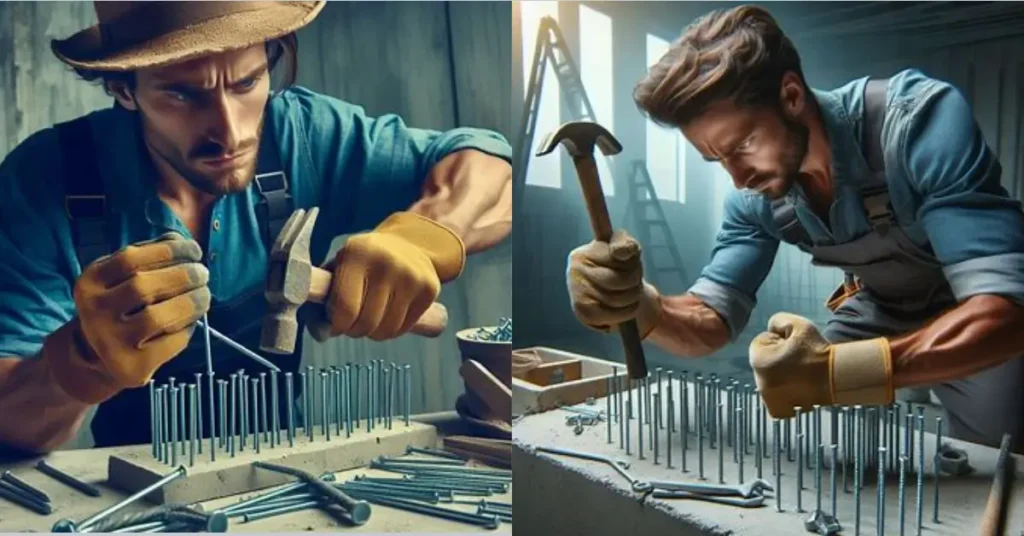
Now that we’ve laid the foundation by understanding the basics of concrete nails and selecting the right type for our project, it’s time to dive into the nitty-gritty of secure fastening techniques. A common misconception is that driving a nail into concrete is a straightforward task, but achieving structural stability requires a bit more finesse.
Step-by-Step Guide to Using Heavy-Duty Concrete Anchors
Let’s begin with a step-by-step guide on using heavy-duty concrete anchors. These anchors are the backbone of secure fastening, providing unparalleled stability.
- Start by selecting the appropriate anchor for your project.
- Consider factors like load-bearing capacity and the nature of the materials you’re working with.
- Next, drill a hole matching the size of your anchor, ensuring a snug fit.
- Once the hole is ready, insert the anchor and tap it gently until it’s flush with the surface.
- This ensures a tight seal and maximum holding power.
- Finally, tighten the anchor securely using a wrench or the recommended tool.
- Voila! You’ve just elevated your fastening game, ensuring your construction stays strong and steadfast.
Ensuring Structural Stability through Quality Nail Placement
Nail placement might seem like a mundane detail, but it can make or break the structural integrity of your project. Precision is the name of the game here. Begin by marking the exact spots where your nails will go. This not only ensures uniformity but also prevents unnecessary stress on the materials.
When it comes to concrete, avoid the temptation to place nails too close to the edges. Doing so can compromise the integrity of the material, leading to cracks or instability over time. Instead, aim for the center of the surface, ensuring a solid anchor point. Additionally, pay attention to the angle of insertion.
Optimal placement guarantees that the nail engages with the material effectively, providing maximum holding power.
By mastering the art of nail placement, you not only enhance the visual appeal of your project but also contribute to its long-term durability. It’s a small detail that pays off in a big way.
DIY Construction Tips with Concrete Nails
Now that we’ve laid the groundwork for using concrete nails with precision, let’s shift our focus to the exciting realm of DIY construction. Many DIY enthusiasts shy away from using concrete nails, thinking they’re reserved for the pros. However, armed with the right knowledge, you can confidently incorporate these nails into your projects, achieving professional-level results.
Practical Tips for DIY Enthusiasts
DIY construction is all about empowerment and creativity, and concrete nails can be your secret weapon. Whether you’re working on a home improvement project or creating something entirely new, consider these practical tips to make the most out of your concrete nails:
Understanding Nail Types:
Before diving into your project, familiarize yourself with the different types of concrete nails available. From finishing nails to masonry nails, each serves a unique purpose. Choose the one that aligns with your specific needs.
Pre-Drilling for Precision:
While concrete nails are designed for tough surfaces, pre-drilling can enhance precision. Use a masonry drill bit to create a pilot hole, ensuring the nail goes in smoothly and without resistance.
Choosing the Right Size:
Size matters when it comes to concrete nails. Opt for a size that complements the thickness of your materials. Using excessively long nails can weaken the structure, while too short nails may not provide sufficient support.
Nail Gun Techniques:
If you have access to a nail gun, leverage its efficiency. Mastering nail gun techniques can significantly speed up your project while ensuring accurate nail placement. Remember, practice makes perfect.
In the following section, we’ll explore the importance of using high-performance construction supplies to bolster the strength and resilience of your projects.
Building Resilience with High-Performance Construction Supplies

As we embark on this journey to master the use of concrete nails, it’s crucial to understand that the strength of your construction is not solely dependent on the nails themselves. The quality of construction supplies you choose plays a pivotal role in determining the resilience of your projects. Let’s unravel the significance of high-performance construction supplies and how they contribute to building structures that stand the test of time.
Importance of Using Top-Notch Construction Supplies
Imagine constructing a masterpiece using subpar materials—it’s akin to building a house of cards in a storm. To ensure the longevity and stability of your projects, investing in high-performance construction supplies is non-negotiable. Here’s why it matters:
Enhanced Durability:
High-quality construction supplies, from adhesives to fasteners, are engineered to withstand environmental factors, ensuring your structures remain robust over the years.
Optimal Bonding:
Utilizing advanced bonding agents enhances the connection between materials, creating a cohesive structure. This is especially critical in projects where the integrity of the build is paramount.
Resistance to Wear and Tear:
Everyday wear and tear can take a toll on your construction. Choosing high-performance supplies ensures your projects can withstand the rigors of time and usage.
Compatibility with Fastener Technology:
Modern construction supplies are designed to complement advanced fastener technology. This synergy maximizes the effectiveness of your chosen construction methods, including the use of concrete nails.
Achieving Industrial Strength with Advanced Fastener Technology
Speaking of technology, let’s explore how advanced fastener technology can elevate the strength of your constructions to industrial levels. Gone are the days of basic nails; today, we have access to fasteners that are engineered for precision and strength.
Consider innovations such as specialty nails and fastening systems designed for heavy-duty applications. These not only provide a secure anchor but also contribute to the overall stability of your project. When combined with high-performance construction supplies, you create a synergy that transforms your construction into a fortress of strength.
Essential Masonry Tools Every Builder Should Have
Now that we’ve explored the importance of construction supplies and fastener technology, let’s turn our attention to the tools that can make or break your construction endeavors. The right masonry tools not only facilitate efficient work but also contribute to the precision and quality of your projects. Whether you’re a seasoned builder or a DIY enthusiast, having the essential tools at your disposal is crucial for unlocking the full potential of concrete nails.
Understanding the Role of Masonry Tools
Masonry tools are the unsung heroes of construction, enabling builders to transform raw materials into structures of strength and durability. Let’s delve into some must-have tools and their roles in ensuring successful construction projects:
Hammer:
The classic tool that needs no introduction. A reliable hammer is essential for driving concrete nails into tough surfaces. Choose a hammer with a comfortable grip and sufficient weight to provide the force needed for effective nail placement.
Masonry Drill Bit:
When it comes to precision, a masonry drill bit is your go-to accessory. This tool ensures clean and accurate holes, allowing for seamless insertion of concrete nails. Pair it with a power drill for optimal efficiency.
Tape Measure:
Precision is key in construction, and a tape measure is your trusty companion for accurate measurements. Whether you’re marking spots for nail placement or ensuring even spacing, a tape measure is indispensable.
Safety Gear:
Construction is not just about the tools; it’s also about personal safety. Invest in safety gear, including gloves and safety glasses, to protect yourself during the construction process.
Must-Have Masonry Tools for Every Builder
Now that we’ve highlighted the importance of these tools let’s discuss a few must-haves for every builder:
Plumb Bob:
Ensures vertical accuracy in your construction, preventing leaning or tilting.
Trowel:
Ideal for applying adhesives and mortar, creating a strong bond between materials.
Spirit Level:
A tool for ensuring horizontal and vertical alignment, promoting a level and stable construction.
Chalk Line:
Facilitates straight and precise markings, aiding in the alignment of materials.
By equipping yourself with these essential masonry tools, you’re not just investing in equipment; you’re investing in the success and durability of your construction projects.
Construction Craftsmanship: From Tools to Techniques
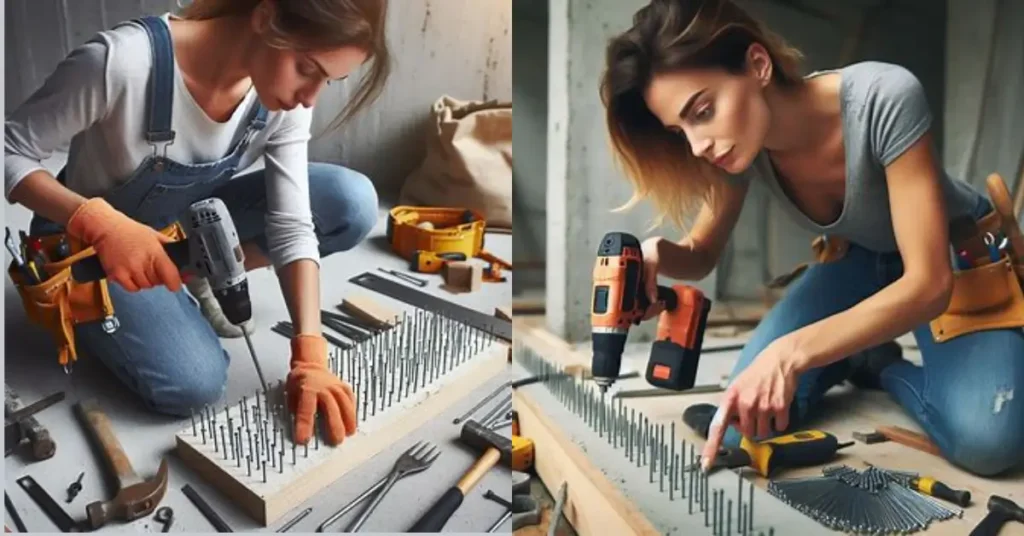
As we venture further into the world of construction, it’s time to appreciate the artistry that underlies every successful project. Construction craftsmanship is not just about using tools; it’s about employing techniques that elevate your work from ordinary to extraordinary. In this section, we’ll explore the nuances of construction craftsmanship, delving into the skills and practices that contribute to the longevity and visual appeal of your structures.
Essential Techniques for Construction Craftsmanship
Precision in Nail Placement:
We’ve discussed the importance of precise nail placement, but construction craftsmanship takes it a step further. It involves a keen eye for detail, ensuring that each nail is not just secure but strategically positioned to enhance both function and aesthetics.
Seamless Material Integration:
A skilled craftsman understands how to seamlessly integrate different materials, creating a cohesive and visually appealing structure. This involves not only the use of high-quality construction supplies but also an artistic touch in combining materials effectively.
Attention to Detail:
It’s the small details that make a big difference. From ensuring uniform spacing between nails to finishing touches that enhance the overall look, construction craftsmanship demands meticulous attention to detail.
The Art of Balancing Functionality and Aesthetics
While functionality is paramount in construction, the aesthetic aspect should not be overlooked. A well-crafted project not only serves its purpose but also adds visual value to its surroundings.
Construction craftsmanship strikes a delicate balance between form and function, creating structures that are not just sturdy but also pleasing to the eye.
Ensuring Structural Integrity with Concrete Bonding Agents
In the realm of construction, achieving optimal bonding between materials is the linchpin for creating structures of enduring strength and stability. Concrete bonding agents, often unsung heroes in construction, play a pivotal role in ensuring that materials are seamlessly integrated, creating a unified and resilient whole. Let’s dive into the significance of these agents and how they contribute to the longevity of your projects.
Understanding the Role of Concrete Bonding Agents
Concrete bonding agents act as the glue that binds different construction materials, ensuring a strong and durable connection. Whether you’re working with concrete, masonry, or other building materials, the proper use of bonding agents enhances the overall structural integrity of your project. Here’s why they are a game-changer:
Improved Adhesion:
Bonding agents enhance the adhesion between surfaces, promoting a strong and lasting bond. This is particularly crucial when working with materials that might not naturally adhere well, such as concrete and certain metals.
Reduced Cracking and Shrinkage:
Concrete is prone to cracking and shrinkage over time. Bonding agents mitigate these issues by improving the tensile strength of the material, reducing the likelihood of cracks and minimizing shrinkage.
Waterproofing Properties:
Some bonding agents come with waterproofing properties, providing an additional layer of protection against moisture-related damage. This is especially beneficial in projects exposed to varying weather conditions.
Optimizing Bonding for Long-Term Stability
Achieving optimal bonding with concrete bonding agents involves a systematic approach:
Surface Preparation:
Before applying the bonding agent, ensure that the surfaces are clean and free from debris. Proper surface preparation sets the stage for a robust bond.
Correct Application:
Follow manufacturer guidelines for the application of bonding agents. Whether it’s brushing, spraying, or applying with a roller, the correct method ensures even coverage and maximum effectiveness.
Compatibility Considerations:
Choose a bonding agent that is compatible with the materials you are working with. Compatibility is key to ensuring a seamless and durable bond.
Industry Insights: Fastener Innovations and Technology
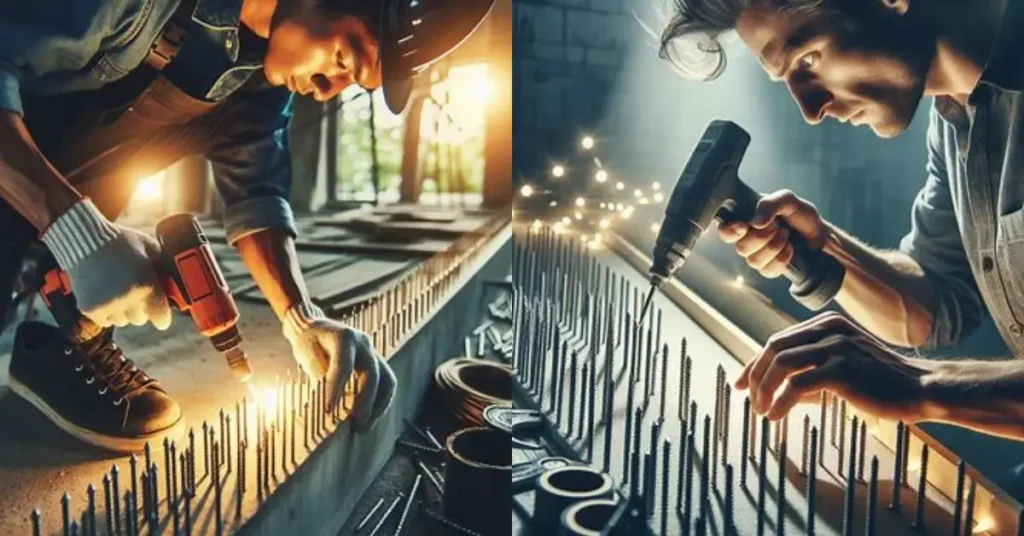
As construction practices evolve, so does the technology behind the fasteners that hold our structures together. In this section, we’ll delve into the exciting realm of fastener innovations, exploring the latest technologies that are reshaping the construction landscape.
From specialty nails to advanced fastening systems, understanding these innovations can empower builders to create structures that not only stand strong but also incorporate cutting-edge techniques.
Overview of Fastener Innovations in the Construction Industry
Fasteners are the backbone of any construction project, and staying abreast of the latest innovations is crucial for ensuring optimal performance. Let’s explore some of the noteworthy advancements shaping the construction industry:
Specialty Nails:
Traditional nails have their place, but specialty nails are designed for specific applications. Whether it’s framing, finishing, or heavy-duty tasks, these specialized fasteners offer enhanced performance, ensuring a secure and lasting connection.
Fastening Systems:
Beyond individual nails, fastening systems are revolutionizing the way materials are joined. These systems often involve a combination of nails, screws, and other elements, providing a comprehensive solution for various construction needs.
Precision Fastening Technology:
In an era where precision is paramount, fasteners equipped with advanced technology ensure accuracy in placement. This not only expedites the construction process but also contributes to the overall quality of the build.
Maximizing the Impact of Fastener Technology
Incorporating these innovations into your construction projects involves strategic decision-making:
Project-Specific Selection:
Consider the unique demands of your project and select fasteners that align with those requirements. Specialty nails and fastening systems should be chosen based on the nature of the materials and the intended purpose.
Efficiency in Construction:
Fastener technology is not just about strength; it’s also about efficiency. Utilize precision fastening technology to streamline the construction process, saving both time and resources.
Future-Proofing Your Projects:
Embrace innovations that not only meet current standards but also position your projects for the future. Choosing fasteners with durability and adaptability ensures that your constructions withstand the test of time.
Nail Design: Merging Form and Function in Construction
In the world of construction, the design of a seemingly simple element like a nail can make a significant impact on the overall success of a project. Nail design goes beyond aesthetics; it involves merging form and function to create fasteners that not only secure materials but contribute to the structural integrity and visual appeal of the final construction.
Let’s dive into the intricacies of nail design and explore why it matters in the grand scheme of construction.
The Significance of Thoughtful Nail Design
Enhanced Holding Power:
Nail design plays a pivotal role in determining how well a nail grips and holds materials together. Features such as a fluted shank or textured surface can enhance holding power, providing a more secure connection.
Minimized Splitting:
A well-designed nail takes into consideration the tendency of certain materials to split when nailed. Features like a tapered point or threads can help minimize splitting, preserving the integrity of the construction materials.
Corrosion Resistance:
The materials used in nail design impact their resistance to corrosion. Choosing materials such as galvanized steel or stainless steel can prevent rusting, ensuring the longevity of the fasteners and the structures they hold together.
Types of Nail Designs for Various Applications
Finishing Nails: These nails are designed for applications where a neat, discreet finish is desired. They often have a small head that can be easily concealed, making them ideal for trim work and delicate projects.
Common Nails:
Known for their versatility, common nails have a larger head and a sturdy build, suitable for a wide range of general construction tasks.
Masonry Nails:
Engineered for use in hard materials like concrete and brick, masonry nails typically have a hardened steel construction and may feature a fluted shank for improved grip.
Selecting the Right Nail Design for Your Project
Choosing the appropriate nail design requires a thoughtful approach:
Consider Material Compatibility:
Different nail designs are suited for different materials. Ensure compatibility between the nail design and the construction materials for optimal results.
Evaluate Load-Bearing Requirements:
The load-bearing capacity needed for your project should influence your choice of nail design. Heavier construction may require nails with enhanced holding power.
Balance Aesthetics with Function:
For projects where the appearance matters, balance the aesthetic qualities of the nail design with its functional aspects. Finishing nails, for example, offer both a secure hold and a polished finish.
Construction Innovation: Paving the Way for Future Excellence
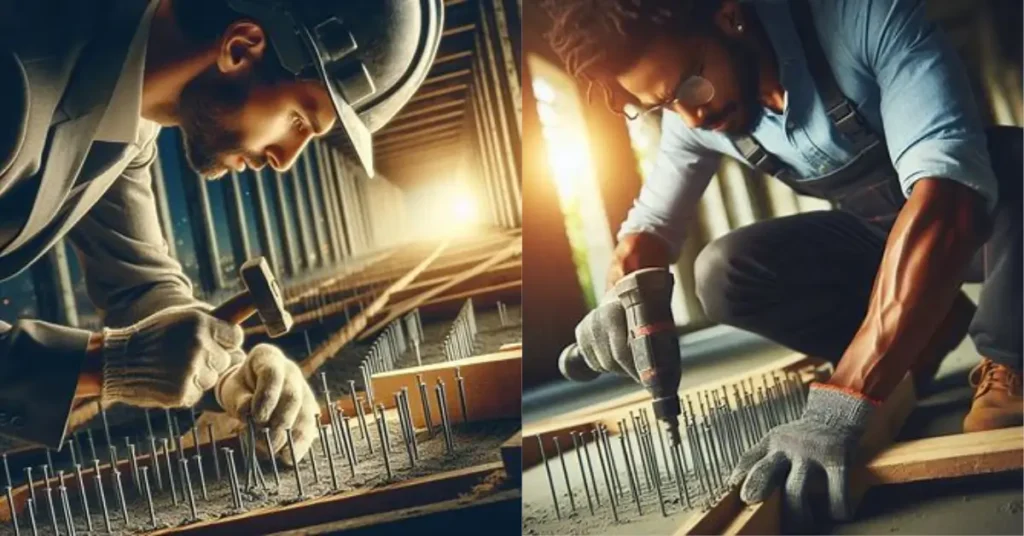
As technology advances and construction practices evolve, embracing innovation becomes essential for staying ahead in the industry. In this section, we’ll explore the latest trends in construction innovation, from smart materials to sustainable practices, and how these innovations are reshaping the way we approach building projects.
By staying informed and incorporating cutting-edge techniques, builders can not only enhance the efficiency of their work but also contribute to a more sustainable and resilient future.
Smart Materials and Construction Technology
Self-Healing Concrete:
Imagine a concrete that can repair its own cracks. Self-healing concrete is an innovative material embedded with capsules of healing agents that activate when cracks form, preventing structural deterioration.
Nanotechnology in Construction:
Nanomaterials are being utilized to enhance the properties of construction materials. From increased strength to improved insulation, nanotechnology is opening new possibilities in construction.
3D Printing:
This revolutionary technology is making waves in construction by allowing for the creation of intricate structures with precision. 3D printing can significantly reduce construction time and material waste.
Sustainable Construction Practices
Green Building Materials:
The shift towards sustainability has led to the development of eco-friendly building materials. Bamboo, recycled steel, and reclaimed wood are examples of materials that reduce environmental impact.
Energy-Efficient Designs:
Sustainable construction goes beyond materials. Energy-efficient designs, incorporating features like solar panels and passive heating, are becoming standard practices for environmentally conscious builders.
Waste Reduction Strategies:
Minimizing construction waste is a key focus in sustainable practices. Reusing materials, recycling construction debris, and adopting circular construction methods contribute to a greener industry.
Integrating Innovation with Concrete Nails
Compatibility with Smart Materials:
As smart materials become more prevalent, builders must consider the compatibility of traditional fasteners, including concrete nails, with these innovative materials.
Sustainability in Fastener Manufacturing:
The push for sustainability extends to the manufacturing processes of construction components. Choosing fasteners produced with eco-friendly practices aligns with the broader goals of sustainable construction.
Efficiency and Precision:
Incorporating construction technology and innovations doesn’t just enhance sustainability but also improves overall efficiency. Precision in nail placement and usage contributes to the longevity of structures.
In the concluding sections, we’ll wrap up our exploration by highlighting the reliability of fasteners and summarizing the key takeaways for revolutionizing your construction projects with the unbeatable strength of concrete nails.
Reliable Fasteners: The Backbone of Strong and Lasting Constructions
In the vast landscape of construction, the reliability of fasteners is the unsung hero that ensures structures stand strong against the test of time. As we conclude our exploration, let’s delve into the key factors that make fasteners reliable, and why they are the backbone of every successful construction project.
From materials to design, understanding what makes a fastener trustworthy is crucial for builders aiming to create structures of lasting strength and durability.
Factors Contributing to Fastener Reliability
Material Quality:
The foundation of any reliable fastener lies in the quality of the materials used. High-grade steel, stainless steel, and other corrosion-resistant alloys are preferred choices, ensuring the fastener can withstand environmental challenges.
Corrosion Resistance:
The longevity of a construction project is directly impacted by the corrosion resistance of its fasteners. Rust and corrosion compromise the integrity of the connection, emphasizing the importance of selecting materials that can withstand the elements.
Proper Coating:
Coatings, such as galvanization, further enhance a fastener’s resistance to corrosion. These protective layers act as a shield against environmental factors, preserving the structural integrity of the construction.
Choosing the Right Fastener for Your Project
Consider Material Compatibility:
Different materials require different types of fasteners. Ensuring compatibility between the fastener and the construction material is fundamental for creating a reliable and enduring connection.
Assess Load-Bearing Requirements:
The load-bearing capacity of a fastener should align with the demands of the project. Heavy-duty constructions necessitate fasteners with enhanced strength and holding power.
Adaptability to Environmental Conditions:
Construction projects often face diverse environmental conditions. Selecting fasteners that can adapt to variations in temperature, humidity, and other factors is essential for long-term reliability.
The Role of Concrete Nails in Reliable Fastening
Concrete nails, with their unique design and robust build, play a crucial role in reliable fastening, especially in masonry and concrete projects. Their hardened steel construction and fluted shanks provide enhanced holding power, ensuring a secure and lasting connection.
When choosing concrete nails, consider factors such as nail length, shank type, and compatibility with the specific application.
Conclusion: Unleashing the Power of Concrete Nails in Construction Excellence

As we reach the culmination of our exploration into the world of construction, it’s time to reflect on the key insights that can transform your approach to building projects. Concrete nails, often underestimated, emerge as the unsung heroes that hold the potential to revolutionize your constructions.
In this concluding section, we’ll recap the journey, emphasize the significance of concrete nails, and leave you with actionable takeaways to elevate your construction endeavors.
Recap of Key Insights
Understanding Concrete Nails:
We commenced our journey by unraveling the basics of concrete nails—specialized fasteners designed for masonry and concrete. Their unique features, such as hardened steel construction and fluted shanks, make them indispensable for creating secure and lasting connections.
Mastering Nail Placement Techniques:
Nail placement is an art that involves precision and strategic thinking. Whether it’s using heavy-duty concrete anchors or paying attention to the angle of insertion, mastering these techniques contributes to the overall stability of your constructions.
DIY Construction Tips:
Empowering DIY enthusiasts, we explored practical tips for incorporating concrete nails into home improvement projects. From understanding different nail types to leveraging nail gun techniques, these insights enable you to take your projects to new heights.
Building Resilience with High-Performance Supplies:
The quality of construction supplies is a linchpin in creating durable structures. High-performance supplies, combined with advanced fastener technology, lay the foundation for constructions that withstand the test of time.
Essential Masonry Tools:
We delved into the importance of essential masonry tools, from hammers to tape measures, that every builder should have. These tools are not just instruments; they are extensions of your craftsmanship, ensuring precision in every detail.
Construction Craftsmanship:
Beyond tools and techniques, we explored the artistry of construction craftsmanship. From achieving precision in nail placement to seamlessly integrating materials, craftsmanship is the secret ingredient that transforms ordinary projects into works of excellence.
Concrete Bonding Agents:
The role of concrete bonding agents in enhancing the connection between materials was highlighted. Surface preparation, correct application, and compatibility considerations are essential for achieving optimal bonding and stability.
Fastener Innovations and Technology:
We ventured into the realm of fastener innovations, exploring technologies such as specialty nails, fastening systems, and precision fastening technology. Staying abreast of these innovations empowers builders to create structures that are both efficient and cutting-edge.
Nail Design:
Nail design emerged as a critical factor, balancing form and function. From enhanced holding power to minimized splitting, thoughtful nail design contributes to the overall success of construction projects.
Construction Innovation:
In the age of innovation, we delved into smart materials, sustainable practices, and the integration of technology in construction. By embracing these innovations, builders can not only enhance efficiency but also contribute to a more sustainable and resilient future.
Reliable Fasteners:
We explored the factors that contribute to the reliability of fasteners, emphasizing the importance of material quality, corrosion resistance, and proper coating. Choosing the right fastener for your project is a foundational step in ensuring lasting connections.
Concrete Nails: The Unbeatable Strength
Concrete nails, with their unbeatable strength and versatility, stand as a symbol of construction excellence. From securing the framing of a house to adding finishing touches, these specialized fasteners have the power to elevate your projects to new heights.
Key Takeaways for Builders
Prioritize Material Compatibility:
Whether it’s selecting construction supplies, masonry tools, or fasteners, prioritize compatibility with the materials you’re working with. This ensures a seamless integration that contributes to the longevity of your constructions.
Master Construction Craftsmanship:
Construction is not just about the tools; it’s about the artistry of craftsmanship. Mastering construction techniques, paying attention to detail, and achieving precision in every aspect will set your projects apart.
Embrace Innovation:
Stay informed about the latest innovations in construction, from smart materials to sustainable practices. Embracing innovation not only enhances efficiency but also positions your projects at the forefront of industry trends.
Choose Reliable Fasteners:
The reliability of fasteners is the backbone of strong and lasting constructions. Consider factors like material quality, corrosion resistance, and proper coating when selecting fasteners for your projects.
Unleash the Power of Concrete Nails:
As a builder, recognize the unbeatable strength of concrete nails. From DIY projects to professional constructions, these specialized fasteners have the potential to transform the way you approach building.
In Conclusion
In the ever-evolving landscape of construction, where every nail driven and every material chosen shapes the future of structures, embracing excellence becomes not just a choice but a responsibility. Concrete nails, with their unique attributes and unparalleled strength, embody the essence of construction excellence.
For more information please visit insightfullhome.com.
FAQs: Unveiling the Secrets of Concrete Nails in Construction
Remember, understanding the nuances of concrete nails and incorporating best practices ensures successful and enduring construction projects.
Question 1. What makes concrete nails different from regular nails?
Answer: Concrete nails are specifically designed for masonry and concrete surfaces. They feature a hardened steel construction and fluted shanks, providing enhanced holding power and durability compared to regular nails.
Question 2. Can I use concrete nails for DIY projects at home?
Answer: Absolutely! Concrete nails are versatile and can be used for a variety of DIY projects. Whether you’re framing a picture or securing baseboards, understanding the right techniques ensures successful outcomes.
Question 3. Do I need special tools to work with concrete nails?
Answer: While basic tools like hammers are essential, having a masonry drill bit for pre-drilling can enhance precision. Additionally, nail guns can expedite the process, making the use of concrete nails more efficient.
Question 4. How do I prevent concrete nails from splitting the material?
Answer: Choosing the right type of concrete nail and ensuring proper nail placement techniques, such as using a pilot hole and avoiding excessive force, can help minimize the risk of splitting in materials.
Question 5. Are there different types of concrete nails for various applications?
Answer: Yes, there are various types of concrete nails designed for specific applications. From finishing nails for delicate projects to masonry nails for tough surfaces, selecting the right type is crucial for optimal results.
Question 6. Can I use concrete nails in outdoor construction projects?
Answer: Absolutely. Concrete nails are suitable for outdoor projects, but it’s essential to choose materials like galvanized steel that offer corrosion resistance to withstand environmental conditions.
Question 7. Are there any safety precautions when working with concrete nails?
Answer: Safety first! Always wear appropriate safety gear, including gloves and safety glasses, to protect yourself. Additionally, follow manufacturer guidelines for the correct use of tools and fasteners.
Question 8. How do I achieve precision in nail placement for a professional finish?
Answer: Achieving precision involves understanding the material, using the right tools, and practicing proper techniques. Pre-drilling, choosing the correct nail size, and mastering nail placement are key factors.
Question 9. Can I use concrete nails in combination with other fastening systems?
Answer: Yes, concrete nails can complement other fastening systems. Depending on your project, combining them with screws or specialty nails can provide a comprehensive solution for various construction needs.
Question 10. Are there eco-friendly options for concrete nails?
Answer: Yes, there are eco-friendly options. Choosing concrete nails made from sustainable materials and manufactured with environmentally conscious practices contributes to a greener construction industry.
Have a nice day!

